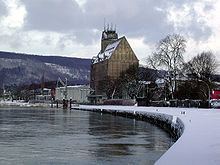District Holzminden Time zone CET/CEST (UTC+1/+2) Population 20,387 (31 Dec 2008) Postal code 37603 | Elevation 89 m (292 ft) Postal codes 37603 Local time Monday 10:26 PM | |
 | ||
Weather 7°C, Wind NW at 6 km/h, 76% Humidity Colleges and Universities HAWK Hildesheim/Holzminden/Goettingen | ||
Holzminden ( [hɔltsˈmɪndən]) is a town in southern Lower Saxony, Germany. It is the capital of the district of Holzminden. It is located on the river Weser, which at this point forms the border with the state of North Rhine-Westphalia.
Contents
- Map of 37603 Holzminden Germany
- History
- Economy
- Religion
- Sights
- Museums
- Educational institutions
- International relations
- Freemen of the town
- Other notable people who have lived in Holzminden
- References
Map of 37603 Holzminden, Germany
History
Holzminden is first mentioned in the 9th century as Holtesmeni. However, the name did not at this time refer to the present city, but to the village of Altendorf, the "old village", which was incorporated into the city in 1922.
During the reign of Louis the Pious (814–840), monks from the Abbey of Corbie in France came to this part of Germany and founded a daughter house at Hethis in the Solling. As it became clear that this site was unviable (owing to lack of access to water) it was abandoned, and a new monastery, Corbeia nova (Corvey Abbey), opened close to the river. Old documents show that many pious donations were given to the Holtesmeni (monastery).
The settlement is believed to have come into being, along with other settlements in the vicinity, in the 6th-7th centuries. Other villages were subsequently abandoned as Holzminden was granted municipal liberties, allowing greater privileges to its inhabitants, and attracting new settlers from the surrounding hinterland.
In 1200 the town was brought under the protection of the prince’s castle of Everstein, and by 1245 it had received a charter. This was granted by the count of Everstein. The town's coat of arms shows the Everstein lion rampant within the open town gate.
From 1408 the town belonged to the Welfen princes; and from the 16th century to the princes of Brunswick of the Wolfenbüttel line. From the 16th century until 1942, Holzminden therefore lay within Brunswick-Lüneburg.
In 1640, during the Thirty Years' War, the town was destroyed by the Imperial troops, a blow from which it only slowly recovered. Until the 20th century Holzminden remained a provincial town of small farmers and holdings.
During World War I, Holzminden was the site of a large civilian internment camp on the outskirts of the town, which held up to 10,000 Polish, Russian, Belgian and French nationals, including women and children (1914–18); and also of a smaller prisoner-of-war camp for captured British and British Empire officers (1917–18).
Economy
Crafts and farming have long ceased to be the main town's sources of income. Holzminden is now a largely industrial town.
In the late 19th century, Dr Wilhelm Haarmann began developing the scent and flavours industry. In 1874, with Ferdinand Tiemann, he succeeded in synthesising vanillin from coniferyl alcohol. More products were subsequently developed. The modern successor of their enterprise is the Symrise factory: Holzminden is a centre of the flavour and fragrance ingredient industry, its products being used throughout the world in cosmetic and food manufacture.
The large Stiebel Eltron company, which produces heating equipment and ovens, has its headquarters in Holzminden.
Religion
As a part of the former territory of Brunswick, Holzminden maintains a Protestant tradition. The church of St. Pauls in Altendorf, dating from before 1200, is the oldest of the town's churches. In its unadorned simplicity it offers a serene place for rest and contemplation. Other churches in the town are named after Luther, St. Michael, St. Thomas and St. Joseph.
Sights
The Tilly House of 1609 is located on the Johannis Square. It has a fine Renaissance door, which survived the fires of the Thirty Years' War. Johann Tserclaes, Count of Tilly, commander of the Imperial forces, is said to have spent a night here.
The Reichspräsidentenhaus links the old part of the town with the Hafendamm and was opened in 1929. The beautiful Glockenspiel (carillon) is very popular, and plays well known tunes at set times.
The steeple of the Lutheran church has become a symbol of Holzminden. The interior was remodelled in 1577, when it was made into a two-room church.
The Severinsche Haus is a richly decorated house dating from 1683. It is the largest of the bourgeois houses, is decorated with a distinctive weathercock, and is known for its slanting floors.
Museums
Educational institutions
International relations
Holzminden is twinned with:
